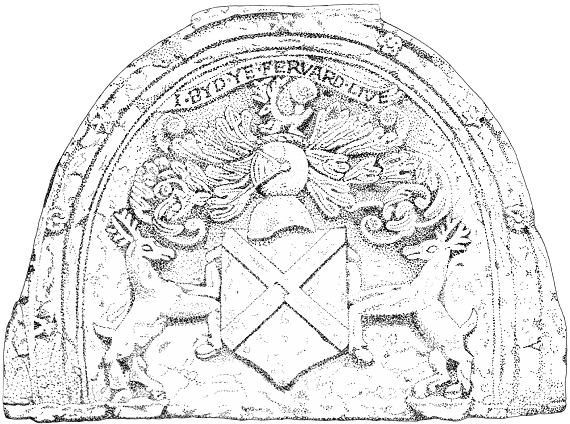Sites
of Historic Significance to Maxwells
The
Tealing Armorial Stone
The Tealing Armorial
stone dates from the early 16th century and was originally set in the walls
of Tealing House, a fortified towerhouse in the hamlet of that name in Forfar.
The Maxwells
of Tealing were a cadet of the principal
house of Caerlaverock. Sir Eustace Maxwell was the progenitor of the branch.
He married the youngest daughter and co-heiress of Sir Hugh Gifford of Yester
and got with her the considerable baron of Tealing to the north of Dundee. Sir
Eustace was the uncle of the first Lord Maxwell and his family became the most
northerly of the landed Maxwells.
The armorial stone is the earliest surviving example of a Maxwell armorial complete
with crest and supporters. The carving is still crisp although naïve and
the mason had problems with the lettering having over compressed the initial
letters he had to change the motto in order to balance the achievement. The
motto should have read “I BYD YE FAIR”.
The arms are clearly those of the Lord Maxwell to whom the Tealing Maxwell remained
loyal. The flat area on the top of the stone served as a plinth for the arms
of the Tealing Maxwells who's saltire was surmounted with a golden heart and
had a crest of a bucks head although by 1672 they had changed it to a hawk facing
to the right.
When the barony of Tealing was sold in the 18th century the new owners, the
Scrymgoers, who were the Provosts of Dundee, removed the armorial to the Tealing
Churchyard were it is set into the Maxwell grave plot.

Wardlaw
Wardlaw is the small round hill to the north east of the Maxwell seat of
Caerlaverock. The hill forms the end of a ridge that runs down the east bank
of the Nith estuary. Warldaw was the rallying place of the Maxwell family. The
cry would go out "I bid ye bide Wardlaw" and Maxwell kinsmen,
bondsmen and tenents alike, would gather together their gear of war and race
for the top af Wardlaw. From the rallying cry came both the Motto af the Lords
Maxwell and the slogan or warcry of the Maxwells, "I bid ye fair"
and "Wardlaw!". In ancient times Wardlaw had been a hillfort
of the Galloway tribes that inhabited these parts. The hillfort was replaced
by a Roman encampment in the first century BC until the Romans withdrew southward
behind Hadrian's Wall.
|
Lord Maxwell's
Memorial Cross
Standing on the roadside at
Woodhouse in the parish of Kirkpatrick Fleming is this monumental stone
cross. It was erected late in the fifteenth century to mark the spot were
John, third Lord Maxwell lost his life. In July 1484, the outlawed Earl
of Douglas in the company of the Duke of Albany at the head of 500 English
horse forayed into Annandale expecting their former tenents to rally to
their side. However the country rose up against them and they were forced
to retreat. John, Lord Maxwell, (He was in fact, the Master of Maxwell,
as his father was still alive but had hung up his sword and retreated
into prayer.) intercepted the invading force on the banks of the Kirtle
and inflicted heavy loss on them. Being sorely wounded, Lord Maxwell was
leaning on his sword at the close of the engagement when a disgruntled
Scotsman named Gask stabbed him from behind, in revenge for the death
of a cousin whom Maxwell, in administering justice as Steward of Annandale,
had caused to be hanged. John died on the spot and his father Robert,
Lord Maxwell, was so heartbroken that he caused the column with its cross
fleury to be raised to commemorate his murdered son.
|
 |
These other sites of
interest are being written up:- Dryfe Sands, Lincluden
Collegate Church, Holywood Abbey, Troqueer Churchyard, Maxwell's Cave.


